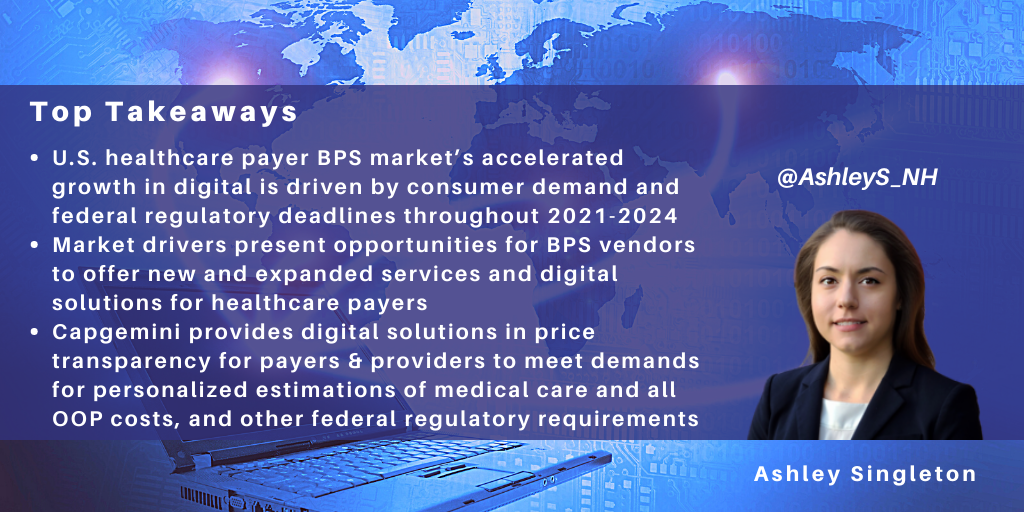posted on Aug 02, 2021 by NelsonHall Analyst

In 2020, the U.S. healthcare payer BPS market saw accelerated growth in the adoption and design of digital solutions across all functional areas. The acceleration is driven mainly by consumer demand for an "Amazon" experience from their health plans and providers, to know the cost of care for associated benefit plans to assist in plan selection or inform decisions about elective procedures and treatments. It is also driven by approaching federal regulation deadlines. Specifically, regulatory requirements from the Cares Act and subsequent rulings from CMS are driving further steps towards interoperability throughout 2021-2024. These requirements follow the initiatives by CMS offering price lookup tools for outpatient procedures and OOP costs for physician visits for Medicare consumers.
Regulatory deadlines drive digital adoption
By January 1, 2022, private payers and group plans must standardize data files to be made publicly available and shared through APIs. The available data will be an opportunity for insurtechs and technology vendors to develop price comparison tools further and price analyses to inform their development.
After January 1, 2023, these payers must offer online plan comparison tools for consumers to view negotiated provider rates and personalized OOP costs estimations for 500 commonly utilized services. This will require real-time underwriting and price aggregation and analysis, with the ability to segment the data by facility and provider. Then, starting on January 1, 2024, individual and group plan consumers will be able to view the estimation of the total OOP costs, including usual tests, procedures, DME, and other items associated with specific treatment plans.
Opportunities for tech vendors to provide services & digital solutions
Without significant digital transformation, meeting the interoperability and price transparency requirements poses a considerable challenge for U.S. healthcare payers. Legacy and "home-grown" systems perpetuate siloed digital solutions, unstandardized data, and difficulties in designing APIs and intake of external data. The disjointed process becomes even more complicated when payers face these challenges on a seasonal basis to perform market assessments, develop products, and price new and renewed plans.
Additionally, payers face the challenge of complying with continual changes in required API formats, currently defined by HL7's FHIR. Payers will need support in converting or implementing the standard format and subsequent testing as regulations and required formats change, such as federal exchange marketplace plans that must implement FHIR APIs with third-party apps for open data access.
Capgemini spotlight: price transparency offerings
U.S. healthcare payers can obtain digital solutions to support regulatory compliance with Capgemini's price transparency solutions. Capgemini has 15 years of experience in the Medicare Advantage space, providing enrollment and member account maintenance management services, solutions, and advisory support. The recent focus has been on designing analytic and AI-driven tools for healthcare payer and provider clients in meeting regulatory guidelines and customer-driven demands for enhanced digital experiences and upfront cost estimations.
Capgemini offers service-line driven pricing for the average cost of medical care from hospitals and healthcare providers in the consumer's area. Capgemini developed the relative pricing guidance for hospitals, with an average of 1200 parameters per hospital for ~700 hospitals, categorizing both operational and overall spend by diagnosis parameters. The hospitals were then ranked into low, medium, high. In addition to overall price analysis, Capgemini parsed hospital spend by service line to provide cost estimations by diagnosis or treatment.
Capgemini is also working with several Blues to estimate OOP cost projections viewable on the member portal. Capgemini designed a cost calculator for a medical procedure at a specific healthcare facility, including the member's expected copay/deductible. A pricing engine was then implemented into a Blue's member portal to provide hyper-personalization, utilizing both internally available eligibility data and the aggregated market data for variable cost pricing. Currently, Capgemini offers implementations of ranking engines enabled by pricing algorithms and provider registries, returning search results of the top 10 providers most relevant for a specific diagnosis or procedure and the estimated cost of copay/deductible/OOP for each provider.
Capgemini's price transparency work is also heavily focused on utilizing MLR for cost-sharing estimations, including telehealth in the cost estimations. For a U.K. health plan, Capgemini implemented a solution to perform plan comparisons against industry standards, such as a specific member with a particular set of demographics and health characteristics, to estimate the eligibility and cost-sharing – competitive pricing. The solution incorporated several analytics tools to perform analysis and reporting on historical cost-sharing.
By the end of 2021, Capgemini's digital solutions in price transparency will integrate the payers' provider search tools to rank relevant providers based on health outcome metrics. Capgemini continues working with certain Blues plans to develop a marketplace with shared data and real-time quoting for care pricing and plan comparisons, involving interoperability and price transparency initiatives to benchmark the cost of services by area and plan. Additionally, Capgemini's development is focused on creating bundled pricing for all procedures and tests associated with a long-term treatment plan, as will be required of healthcare payers by 2024.
Increased demand and opportunities for digital transformation in the near future
The challenges faced by U.S. healthcare private and group payers present opportunities for technology vendors to provide digital solutions and services for payers to meet both the regulatory requirements and consumers' digital experience expectations. Client engagement types will vary by payer size, as many large payers only require specific solution design and implementation within their existing systems, while many mid-market and regional plans will be looking for BPaaS models of engagement with technology vendors. Payers will be looking for digital solutions to provide personalized real-time quotes for procedures and later for bundled pricing by the treatment plan and expanded data sharing to enable price transparency initiatives.
